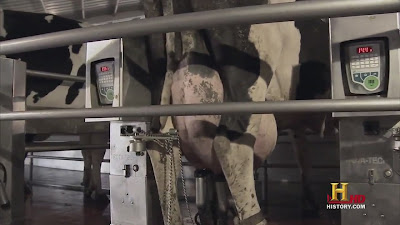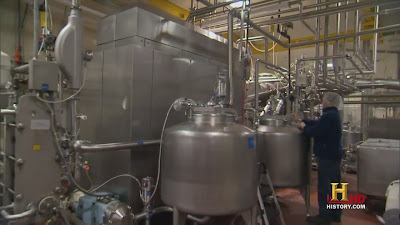














Flow Sensor. If the sensor detected the flow of cow is decreasing, the cow would be released.





The separator consits of several cone-shaped disks which spin together around seven
thousand revolution per minute allowing the heavier skin to aggregate outside and
the cream (butter fat, milk fat, cream fat ) falls down to the center.


The cream.






Most plastic milk containers are made from high-density polyethylene, also known as HDPE or No. 2 plastic. Plastic milk jugs have a lot going for them. At just 4 ounces per half-gallon container, they're so light that relatively little energy is required to ship them from the manufacturer to the dairy, and then on to the retailer and finally the consumer's home.
The jugs are also recyclable, at least in theory. While plastic bottles can be melted down and made into new bottles, none of the milk containers in the United States are actually made from recycled material. That's because of safety concerns over bacterial and chemical contamination, and strict FDA guidelines for the manufacture of food packaging from such second-hand sources. When it's reclaimed, plastic from milk bottles is usually turned into toothbrushes, flower pots, and children's toys, among other things.
A second kind of milk container—the gable-top carton—is made from paperboard and coated with a layer of low-density polyethylene. Like the plastic bottle, gable-top cartons are made from virgin materials. Recycled paper isn't as strong as the stuff straight from the trees, so a recycled container capable of carrying that much milk would have to be much thicker, heavier, and more expensive.
Paperboard is made of trees, a renewable resource, which is good. And they're only 1 ounce (25 percent) heavier than plastic bottles. But the environmental positives end there. Making paper is a resource-intensive process, requiring huge amounts of water, fossil fuels, and chemical bleaches.
And then there are the milk containers made of glass. The major ingredients—sand, soda ash, and limestone—aren't renewable, but they are plentiful. Glass is really heavy, though. If you filled a delivery truck with half-gallon bottles of milk, the glass would constitute about one-third of the total weight of the shipment, compared with 5 percent for plastic and 7 percent for gable-top cartons. The other issue of glass bottle milk is the milk didn't affected by the container.




converting the liquid milk into the more solid state.
























enough to get through.













Condensed Milk with Strawberry.


the concentrated mile sprayed as the mist inside the drying chamber, here the milk drop
dried in the hot air. Instant Nonfat Dry Milk.

Milk Powder Ice Cream.
No comments:
Post a Comment